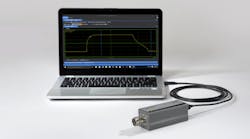Demonstrations of RF/microwave power measurements at the EDI CON 2016 Boonton booth were performed with a pair of new USB-based real-time, true-average power sensors, with models operating from 6 kHz to 6 GHz and 10 MHz to 6 GHz. The RTP4000 series of power sensors boasts a wide dynamic range, -60 to +20 dBm, with measurement speed of 100,000 measurements/s to meet the needs of the most demanding production test environments.
The true average power sensors can measure the power levels of pulsed, modulated, and continuous-wave (CW) signals, and feature a pulse profiling trace mode with 175-kHz video bandwidth. They are controlled with connection to a personal computer (PC) by means of intuitive measurement software. In fact, by connecting a number of the USB sensors to a single computer, synchronized multichannel power measurements can be performed.
To learn more about the USB real-time, true-average power sensors or to see them in action, visit Boonton at EDI CON Booth #712.

